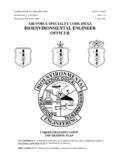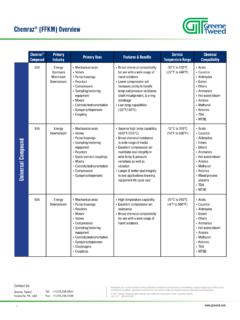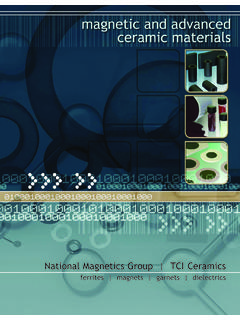Transcription of DEPARTMENT OF THE AIR FORCE CFETP 1N0X1
1 DEPARTMENT OF THE AIR FORCE CFETP 1N0X1 Headquarters US Air FORCE Parts I and II Washington, DC 20330-1030 26 September 2016 Air FORCE Specialty Code 1N0X1 ALL SOURCE INTELLIGENCE ANALYST CAREER FIELD EDUCATION AND TRAINING PLAN ACCESSIBILTY: Publications and forms are available on the e-publishing website at for downloading or ordering. RELEASABILTY: There are no releasability restrictions on this publication. 2 CAREER FIELD EDUCATION AND TRAINING PLAN All Source Intelligence Analyst AFSC 1N0X1 Table of Contents PART I Preface 4 Abbreviations/Terms Explained 5 Section A General Information 10 Purpose of the CFETP Use of the CFETP Coordination and Approval of the CFETP Section B Career Progression and Information 11 Specialty Description Skill/Career Progression Apprentice Level (3) Journeyman Level (5) Craftsman Level (7) Superintendent Level (9) Training Decisions Community College of the Air FORCE Career Field Path Section C Skill Level Training Requirements 20 Purpose Specialty Qualifications Apprentice Level (3) Journeyman Level (5) Craftsman Level (7) Superintendent Level (9)
2 Section D Resource Constraints 24 PART II Section A Specialty Training Standards 26 Section B Course Objective List 39 3 Section C Support Materials 39 Section D Training Course Index 39 Section E MAJCOM Unique Training 41 Summary of Changes: Line items have been revised to reflect changes in requirements. STS Intelligence Fundamental Core (Common Core) line items have been moved to a stand-alone CFETP1NX, but are a mandatory requirement for inclusion into this full STS. OPR: 315 TRS/XP Certified By: AF/A2 CEM (CMSgt Mark S. Allen) Supersedes: CFETP 1N0X1 , 24 August 2016 Number of Printed Pages: 41 4 All Source Intelligence Analyst AFSC 1N0X1 CAREER FIELD EDUCATION AND TRAINING PLAN Part I Preface 1. This Career Field Education and Training Plan ( CFETP ) is a comprehensive education and training document that identifies life-cycle education/training requirements, training support resources, and minimum core task requirements for this specialty.
3 The CFETP will provide personnel a clear career path to success and will instill rigor in all aspects of career field training. NOTE: Civilians occupying associated positions will use Part II to support duty position qualification training. 2. The CFETP consists of two parts; both parts of the plan are used by supervisors to plan, manage, and control training within the career field. Part I provides information necessary for overall management of the specialty. Section A explains how everyone will use the plan; Section B identifies career field progression information, duties and responsibilities, training strategies, and career field path; Section C associates each level with specialty qualifications (knowledge, education, ); Section D indicates resource constraints. Some examples are funds, manpower, equipment, facilities; Section E, when used, identifies transition training guide requirements.
4 Part II includes the following: Section A identifies the Specialty Training Standard (STS) and includes duties, tasks, technical references to support training, Air Education and Training Command (AETC) conducted training, wartime course, core task, and correspondence course requirements; Section B contains the course objective list and training standards supervisors will use to determine if Airmen satisfied training requirements; Section C identifies available support materials. An example is a Qualification Training Package (QTP), which may be developed to support proficiency training. These packages are identified in AFIND8, Numerical Index of Specialized Educational Training Publications; Section D identifies a training course index supervisors can use to determine resources available to support training. Included here are both mandatory and optional courses; Section E identifies MAJCOM unique training requirements supervisors can use to determine additional training required for the associated qualification needs.
5 3. Using guidance provided in the CFETP will ensure individuals in this specialty receive effective and efficient training at the appropriate point in their career. This plan will enable us to train today's work FORCE for tomorrow's jobs. At unit level, supervisors and trainers will use Part II to identify, plan, and conduct training commensurate with the overall goals of this plan. 5 ABBREVIATIONS/TERMS EXPLAINED Advanced Training (AT). Formal course which provides individuals who are qualified in one or more positions of their Air FORCE Specialty (AFS) with additional skills/knowledge to enhance their expertise in the career field. Training is for selected career Airmen at the advanced level of the AFS. Air FORCE Career Field Manager (AFCFM). An individual on the Headquarters United States AF staff who is responsible for career development programs, functional management and utilization, specialty standards and requirements, training, and FORCE management for a family of Air FORCE Specialties (1 NXXX).
6 This includes identifying the task requirements and training for an AF specialty (AFS) or occupational series. This individual will review and/or approve all proposed changes to specialties within their career family. Air FORCE Job Qualification Standard (AFJQS). A comprehensive task list which describes a particular job type or duty position. They are used by supervisors to document task qualifications. The tasks on AFJQS/Command Job Qualification Standard are common to all persons serving in the described duty position. Air FORCE Specialty (AFS). A group of duty positions that require common qualifications identified by a title and code. Air FORCE Specialty Code (AFSC). A combination of alpha-numeric characters which are used to identify a specific career field and qualification level for Air FORCE officers and enlisted personnel.
7 Air FORCE Specialty Manager (AFSM). An individual on HQ USAF staff, responsible to the AFCFM for overseeing all aspects of a particular AFS (1N0XX). Coordinates with MAJCOM functional and training managers, technical training center personnel, Career Development Course writers, and various Subject Matter Experts (SMEs) on career path development and identification of Career Field Education and Training Plan training tasks items to meet national, tactical, and FORCE training requirements. Other responsibilities include reviewing AFS manpower utilization, managing AFS classification guidance, and overall status of the health of their particular AFS. Bachelor of Science in Intelligence (BSI). The BSI degree is offered through the National Intelligence University as a fourth year degree completion program that affords those students who have earned three years of undergraduate credits a means of completing their degree requirements.
8 The 11 month intelligence curriculum consists of eleven core courses and six electives to include a summer term capstone project focusing on a current intelligence issue. Career Development Course (CDC). Self-paced, correspondence course published to provide the information necessary to satisfy the career knowledge component of on-the-job training (OJT). These courses are developed from references identified in the CFETP correlating with mandatory knowledge items listed in the Air FORCE Enlisted Classification Directory (AFECD). CDCs will contain information on basic principles, techniques, and procedures common to an 6 AFSC. They do not contain information on specific equipment or tasks unless best illustrating a procedure or technique having utility to the entire AFSC. Career Field Education and Training Plan ( CFETP ).
9 A CFETP is a comprehensive, multipurpose document encapsulating the entire spectrum of education and training for a career field. It outlines a logical growth plan that includes training resources and is designed to make career field training identifiable, to eliminate duplication, and to ensure this training is budget defensible. Career Training Guide (CTG). A document that uses Task Modules (TMs) in lieu of tasks to define performance and training requirements for a career field. Chief Enlisted Manager (CEM). A five-digit code ending in 00 to identify CMSgt and CMSgt selectees as top enlisted managers in both highly technical skills and in broad areas of managerial competence. Continuation Training. Additional training exceeding requirements with emphasis on present or future duty assignments. Core Intelligence Training (CIT).
10 Fundamental training across the 1 NXXX Career Field. Core Task. A task AFCFMs identify as a minimum qualification requirement within an Air FORCE specialty or duty position. Core Tasks for the AFS can be either task- or knowledge-based and are the STS line items fundamental to meeting these core competencies. Each MAJCOM is responsible for developing the minimum standard to which each core task will be trained. Core tasks are common to all personnel within an AFS required to perform intelligence functions. The skills (or knowledge) must be trained, maintained, and certified, regardless of duty position/location and are based upon skill level. Core Functions. The mission of the Air FORCE is to defend the United States and protect its interests through air, space, and cyber power. The following are the core functions IAW FY15 Posture Statement: 1.

















